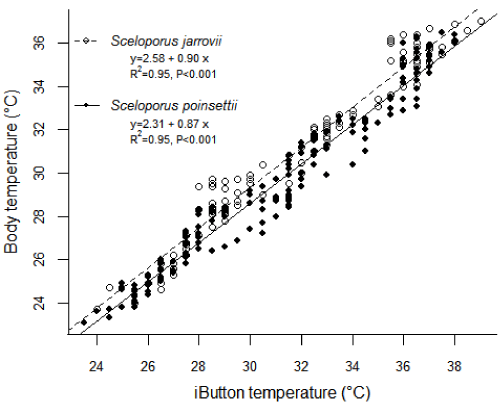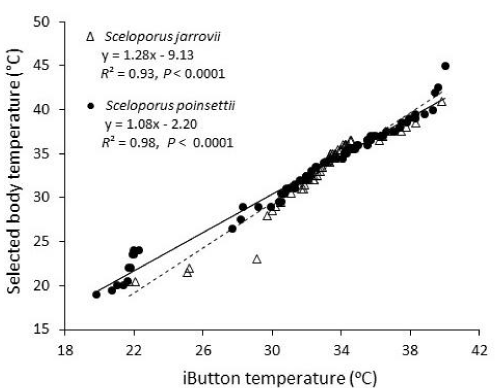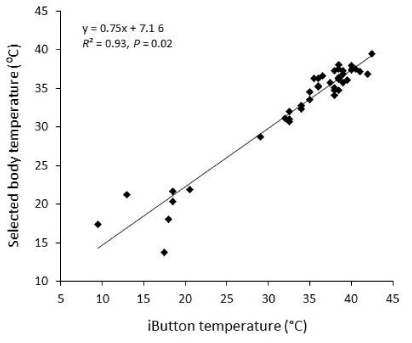Global Journal of Ecology
Selected body temperature in Mexican lizard species
Héctor Gadsden1*, Sergio Ruiz2 Gamaliel Castañeda3 and Rafael A Lara-Resendiz4
2Student, Posgrado Ciencias Biológicas, Instituto de Ecología, AC, km. 2.5 carretera antigua a Coatepec No. 351, Congregación El Haya, Xalapa, CP 91070, Xalapa, Veracruz, México
3Researcher-Professor, Facultad en Ciencias Biológicas, Universidad Juárez del Estado de Durango, Avenida Universidad s/n, Fraccionamiento Filadelfia CP 35070, Gómez Palacio, Durango, México
4Postdoc Researcher, Centro de Investigaciones Biológicas del Noroeste, Playa Palo de Santa Rita Sur, 23096 La Paz, Baja California Sur, México
Cite this as
Gadsden H, Ruiz S, Castañeda G, Lara-Resendiz RA (2018) Selected body temperature in Mexican lizard species. Glob J Ecol 3(1): 001-004. DOI: 10.17352/gje.000007Lizards are vertebrate ectotherms, which like other animals maintain their body temperature (Tb) within a relatively narrow range in order to carry out crucial physiological processes during their life cycle. The preferred body temperature (Ts) that a lizard voluntarily selecTs in a laboratory thermal gradient provides a reasonable estimate of what a lizard would attain in the wild with a minimum of associate cosTs in absence of constrainTs for thermoregulation. In this study we evaluated accuracy of modified iButtons to estimate Tb and Ts of three lizard species (Sceloporus poinsettii and Sceloporus jarrovii in northeastern Durango, and Ctenosaura oaxacana in southern Oaxaca, Mexico). We used linear regression models to obtain equations for predicting Tb and Ts of these species from iButtons. ResulTs from regression models showed that TiButton is a good indicator of Tb for S. jarrovii and S. poinsettii during calibration process. In the same way, TiButton is a good indicator of Ts for S. poinsettii, S. jarrovii and C. oaxacana through experimental gradient. Thus, external measuremenTs using modified iButtons provided an accurate measurement of Tb for S. jarrovii and S. poinsettii and Ts for three species of lizards in this study. In laboratory, body temperature (Tb), and preferred temperature (Ts) obtained from S. jarrovii and S. poinsettii fell within the range of Tbs of other lizards in the family Phrynosomatidae. Ts measured for S. jarrovii, S. poinsettii, and C. oaxacana are within the range observed for lizards. Therefore, thermal preferences appear more phylogenetic that certain environmental factors present in each population of lizards of this group.
Abbreviations
Ts: Preferred body temperature; Tb: Body temperature; TiButton: Temperature measured by modified dataloggers.
Introduction
The preferred body temperature (Ts) that a lizard voluntarily selecTs in a laboratory thermal gradient (indoor enclosure with negligible wind and specific radiant heating regime) provides a reasonable estimate of what a lizard would attain in the wild with a minimum of associate cosTs in absence of constrainTs (biotic and abiotic factors) for thermoregulation [1,2].
The recent accessibility of small dataloggers has potential to revolutionize collection of thermal data in small animals [3-5]. The DS1921 Thermochron iButton (Dallas Semiconductor, TX USA) is an ideal device to quantify temperatures [6]. An iButton is a small lightweight datalogger (~14 mm diameter, 3 mm wide, and 1.5 g) that can store an enormous amount of measuremenTs and their dates (2048 consecutive temperature readings) facilitating long term studies. In addition, iButtons are easily programmed and have a simple interface. Robert and Thompson [6], describe a technique for modifying an iButton, which involves removing the stainless-steel housing exposing the electronic board and apply a coating of plastic (Plasti Dip Spray, Performix, USA) to reduce the size and weight of iButtons. The modified iButton can then be glued to the skin of small reptiles. Given the relatively low thermal capacity of iButtons, it is possible to obtain a good estimate of Tb. Although, Robert and Thompson [6], did not verify the accuracy of iButtons to predict Tb of animals.
In this study we evaluated accuracy of modified iButtons to estimate Tb and Ts of three lizard species (Sceloporus poinsettii, Sceloporus jarrovii, and Ctenosaura oaxacana). We used linear regression models to obtain equations for predicting Tb and Ts of these species.
Materials and Methods
Study Sites and Lizard Species
The study of sympatric species S. jarrovii and S. poinsettii was conducted at Las Piedras Encimadas canyon (25°38’47”N, 103°38’40”W), 25 km northwest of Gomez Palacio, Durango, Mexico (elevation 1,425 m). The climate at the site is seasonal, with the highest temperature and rainfall occurring in spring and summer, respectively. Mean annual precipitation is 239 mm and mean annual temperature is 21°C [7]. Vegetation is within the Lechuguilla Scrub biome (Matorral Xerófilo with Agave lechuguilla [8].
Sceloporus jarrovii is a lizard species of montane foresTs and some isolated mountain habitaTs in the Chihuahuan and Sonoran DeserTs with extensive rock exposure and crevices, at elevations between 1370-3550 m [9,10]. Sceloporus poinsettii is largely saxicolous, inhabiTs vegetated areas in canyons in arid and semiarid regions within Chihuahuan Desert, as well as forested slopes of Sierra Madre Occidental [11,9].
The lizard Ctenosaura oaxacana inhabiTs at Montecillo Santa Cruz in southern Oaxaca (16°22’05”N, 94°35’15.4”W) within Isthmus of Tehuantepec. The study site has tropical climate with a rainfall of 800 mm, and annual average temperature of 27.6 °C. The vegetation is mainly early successional and composed of shrubs and bushes [12-14]. The habitaTs used by this species are dry forest, Nanchal (Byrsonima crassifolia), grassland, riparian vegetation, and mangrove [15].
Calibration
External data loggers generally provide accurate estimates of internal body temperatures in small ecthoterms that have limited physiological capacity to control rates of heat exchange [16].
In order to observe relationship between Tb and temperature measured by modified dataloggers (TiButton) of adult lizards, three S. poinsettii and two S. jarrovii were collected by noosing in October 2012 and fitted with modified iButtons fixed dorsally on the back of lizards with cyanoacrylate glue [6]. Furthermore, in order to measure Tb, we inserted a K-type thermocouple into the cloaca of each lizard attached to a digital thermometer. We used masking tape to keep the thermocouple within the cloaca.
Thermochron iButtons were programmed to measure TiButton per minute and simultaneously Tb of lizards was measured. Lizards were placed within a chamber of approximately 40 x 25 x 30 cm, equipped with incandescent light bulbs controlled by a thermostat for adjusting temperature. The temperature of each of five lizards was measured during one hour by incremenTs of about 5 °C (within chamber) for 20-minute intervals. The experiment began with 25 °C, after 20 min of measurement increased to 30 °C, and finally at 35 °C.
Calibration temperature analysis
Analysis of covariance (ANCOVA) was performed to observe relationship between a change in Tb and TiButton, and to determine whether there is a difference between those lizard species. Within analysis, Tb and TiButton were assigned as covariates and the fixed factor was the species. Then, we developed a regression model for each species. The models met assumptions of normality and homoscedasticity of residuals. All data analysis and figure were performed using statistical package R [17].
Selected body temperature
AdulTs of S. poinsettii and S. jarrovii were collected by noosing in October 2012 and separated into two categories based on individuals with presence or absence of iButtons attached on the back of both lizard species. Preferred body temperatures (Ts) and iButton temperatures (TiButton) of captive lizards were measured in a thermal gradient (S. poinsettii: n = 9 lizards without iButtons and n = 8 lizards with iButtons; and S. jarrovii: n = 10 lizards without iButtons and n = 6 lizards with iButtons). The thermal gradient consisted of a 1 × 1.5 × 0.5 m wooden enclosure and divided lengthways into six separate compartmenTs. Heat was provided at one end of each compartment by a 250 W infrared lamp. The laboratory climate was adjusted so that at one end of thermal gradient reached 50 °C and 20 °C at other end, thus forming a continuous gradient [18]. We collected lizards four days before Ts were measured to allow lizards to acclimate for at least 18 h prior to testing. Ts of all lizards was measured every hour from 9:00 until 18:00 hours (the normal activity period of each species). We inserted a K-type thermocouple in the cloaca using the same digital thermometer to measure Tb. Simultaneously; TiButton was measured with iButtons attached on the back of both lizard species. Preferred temperature ranges were generated with upper and lower bounds established by using central 50% of body temperatures per lizard [18]. By using central 50%, the outliers resulting from nonthermoregulatory behavior (e.g., escape or exploratory behavior) were eliminated [18].
Moreover, Tsel for C. oaxacana (n = 7 lizards) was also measured in a thermal gradient inside a wooden box with similar dimensions to those described above and with same range of temperatures between 20 °C and 50 °C. Individuals were picked by noosing each hour to record simultaneously both temperatures, one automatically registered by modified iButton (TiButton), and the other (Ts) by a cloacal thermometer Miller and Weber®.
Selected body temperature analysis
To test whether there was significant difference between Ts (measured through a digital thermometer) of S. poinsettii and Ts of S. jarrovii, and between TiButton and Ts in both species, were compared with a Student t test when data met requiremenTs for use of parametric tesTs (normality and homogeneity of variances, test Kolmogorov-Smirnov and Levene, respectively), and if not we used nonparametric Mann-Whitney test. We also performed a multiple regression analysis to determine relationship of TiButton with Ts and compared slope for each species. Data analysis and graphics processing programs were performed with Systat 13®. The tesTs were performed with P ≤ 0.05 and means are expressed ± 1 SE, n and total range.
Moreover, for C. oaxacana a Wilcoxon two-sample test was performed in order to test whether there was significant difference between Ts measured through a cloacal thermometer and TiButton measured by modified iButtons.
All lizards used in this study were marked with a nontoxic paint to identify lizards that had already been measured so that repeat measuremenTs were not made and then released at the exact site of capture.
ResulTs
Calibration
The mean Tb and mean TiButton of three individuals of S. poinsettii was 29.5 ± 0.31 °C (range, 23.1 - 36.5 °C, n = 118) and 31.1 ± 0.33 °C (range, 23.5 – 38.0 °C, n = 120), respectively. Moreover in two individuals of S. jarrovii, mean Tb and mean TiButton was 31.1 ± 0.32 °C (range, 23.7 – 37.0 °C, n = 118) and 31.9 ± 0.33 °C (range, 24.0 – 39.0 °C, n = 120), respectively.
The ANCOVA analysis showed a significant difference between two species (F1, 297 = 70.71, P < 0.0001), so we proceeded to perform a regression model for each species (Figure 1). The model met assumption of normality of residuals and homoscedasticity. The linear equation obtained for S. poinsettii was Tb = 1.29 + 0.91 x TiButton (n = 180, R2 = 0.95, P < 0.0001), and S. jarrovii was Tb = 1.38 + 0.93 x TiButton (n = 120, R2 = 0.95, P < 0.0001).
Selected body temperature
The mean Ts and mean TiButton of S. poinsettii was 32.3 ± 0.60 °C (n = 76, range, 19.8 – 40.0 °C) and 33.0 ± 0.66 °C (n = 76, range, 19.0 – 45.0 °C), respectively. Moreover for S. jarrovii, mean Ts and mean TiButton was 32.7 ± 0.44 °C (n = 57, range, 21.7 – 39.8 °C) and 33.0 ± 0.59 °C (n = 57, range, 20.5 – 41.0 °C), respectively.
A Mann-Whitney U-test on Ts between S. poinsettii and S. jarrovii revealed no significant differences (W = 5,842, P = 0.41). Furthermore, a Student t-test revealed no significant differences between Ts and TiButton for S. poinsettii (t = 0.67, df = 150, P = 0.501), and a Mann-Whitney U-test revealed no significant differences between Ts and TiButton for S. jarrovii (W = 5,247.5, P = 0.48).
Both S. poinsettii as S. jarrovii Ts was positively related with TiButton (Figure 2). The linear equation obtained for S. poinsettii was Ts = 1.08 x TiButton – 2.20 (n = 76, R2 = 0.98, P < 0.0001), and S. jarrovii was Ts = 1.28 x TiButton – 9.13 (n = 57, R2 = 0.93, P < 0.0001).
Furthermore, mean Ts and mean TiButton of C. oaxacana was 32.1 ± 0.6 °C (n = 37, range, 13.1 – 39.5 °C) and 32.1 ± 1.0 °C (n = 37, range, 14.1 – 39.1 °C), respectively; which were not significantly different (Mann-Whitney U-test, W = 720, P = 0.7), and we proceeded to perform a regression model between Ts and TiButton (Figure 3) and relationship was positive. The linear equation obtained for C. oaxacana was Ts = 0.75 x TiButton + 7.16 (n = 37, R2 = 0.93, P = 0.02).
Discussion
In laboratory, body temperature (Tb), and preferred temperature (Ts) obtained from S. jarrovii and S. poinsettii fell within the range of Tbs of other lizards in the family Phrynosomatidae, with a mean Tb of 35.2 °C [19-21]. However, there is substantial variation in Tbs among species and values range from 26.8 and 41.5 °C. In the present study, Tb (calibration) for S. jarrovii and S. poinsettii was 31.1 and 29.5 °C, respectively; whereas TiButton was 31.9 and 31.1 °C, respectively. Furthermore, Ts for S. jarrovii and S. poinsettii were 32.7 and 32.3 °C, respectively; whereas TiButton was 33.0 and 33.0 ºC, respectively. Moreover, Ts and TiButton for C. oaxacana were 32.1 and 32.1 °C, respectively. Ts measured for S. jarrovii, S. poinsettii, and C. oaxacana are within the range observed for lizards, which generally approaches 30 °C [22,23]. Therefore, thermal preferences appear more phylogenetic that certain environmental factors present in each population of lizards of this group.
In this study there was a significant relationship between TiButton and Tb for S. jarrovii and S. poinsettii, as well between TiButton and Ts for three species of lizards. ResulTs from regression models showed that TiButton is a good indicator of Tb for S. jarrovii and S. poinsettii during calibration process. In the same way, TiButton is a good indicator of Ts for S. poinsettii, S. jarrovii and C. oaxacana through experiment gradient. External and internal temperature measuremenTs were highly correlated. Thus, external measuremenTs using modified iButtons provided an accurate measurement of Tb for S. jarrovii and S. poinsettii and Ts for three species of lizards in this study.
Our data confirm that iButtons must be calibrated prior to placing on the lizards. The failure to do so can result in the underestimation of body temperature by as much as 1.4 ºC [24]. Slopes and R2 data of these study suggest that a linear fit to calibration data is adequate for physiological temperature ranges. The modified iButtons are thus a convenient device for making these preliminary studies and should aid in improving the quality of selected temperature data and other metabolic data obtained in laboratory.
Funding for this project was provided to HG by Instituto de Ecología, A. C. (project: 20021/10050). Permit SEMARNAT-SPGA/DGVS/07946/08.
- Huey RB, Slatkin M (1976) Costs and benefits of lizard thermoregulation. Q Rev Biol 51: 363-384. Link: https://goo.gl/o1uhYB
- Pough FH, Gans C (1982) The vocabulary of reptilian thermoregulation. In: Gans, C. and F.H. Pough (eds) Biology of the Reptiles, Vol. 12: 17-23. Academic Press, London. Link: https://goo.gl/Hv7q5Q
- Muller JM, Rakestraw DL (1994) Evaluation of a new miniature temperature data logger. Herpetol Rev 26: 22-23. Link: https://goo.gl/nDMGAf
- Angilletta MJ Jr, Krochmal AR (2003) The Thermochron: A Truly Miniature and Inexpensive Temperature-Logger. Herpetol Rev 34: 31-32. Link: https://goo.gl/cacCDo
- Angilletta MJ, Jr (2009) Thermal adaptation: A theoretical and empirical synthesis. Oxford University Press, USA. Link: https://goo.gl/1Cq458
- Robert KA., Thompson MB (2003) Reconstructing thermochron iButtons to reduce size and weight as a new technique in the study of small animal thermal biology. Herpetol Rev 34: 130-132. Link: https://goo.gl/6sS51c
- CONAGUA-SARH (2006) Dirección de hidrología- Departamento de cálculo hidrométrico y climatológico. Durango: Estación Lerdo.
- Rzedowski J (1981) Vegetación de México. Limusa, México. Link: https://goo.gl/wukm2r
- Lemos-Espinal JA, Smith HM (2007) Amphibians and reptiles of the state of Chihuahua, Mexico. Universidad Nacional Autónoma de México y Comisión Nacional para el Conocimiento y Uso de la Biodiversidad, México.
- Gadsden H, Estrada-Rodríguez JL (2007) Ecology of the spiny lizard Sceloporus jarrovii in the central Chihuahuan desert. Southwest Nat 52: 600-608. Link: https://goo.gl/gmbsDJ
- Gadsden H, Rodríguez-Romero FJ, Méndez-de la Cruz FR, Gil-Martínez R (2005) Ciclo reproductor de Sceloporus poinsettii Baird y Girard 1852 (Squamata: Phrynosomatidae) en el centro del desierto Chihuahuense, México. Acta Zool Mex (Nueva Ser) 21: 93-107. Link: https://goo.gl/kY5ZSX
- Pérez-García E, Meave J, Gallardo C (2001) Vegetación y flora de la región de Nizanda, Itsmo de Tehuantepec, Oaxaca, México. Acta Bot Mex 56: 19-88. Link: https://goo.gl/4b9B5D
- Farias V (2004) Spatio-temporal ecology and habitat selection of the critically endangered tropical hare (Lepus flavigularis) in Oaxaca, Mexicio. PhD Dissertation, Massachusetts University, USA. Link: https://goo.gl/nMCEf9
- Sántiz LE (2005) Selección de hábitat y densidad de la liebre del Istmo Lepus flavigularis (Wagner 1844) en Oaxaca México. Master Dissertation, Instituto de Ecología, A.C. México.
- Rioja T, Carrillo-Reyes A, Espinoza-Medinilla E, López-Mendoza S (2012) Basic ecology of the Oaxacan Spiny-tailed Iguana Ctenosaura oaxacana (Squamata: Iguanidae), in Oaxaca, Mexico. Rev Biol Trop 60: 1613-1619. Link: https://goo.gl/xM6XLx
- Bakken GS (1992) Measurement and application of operative and standard temperatures in ecology. Amer Zool 32: 194-216. Link: https://goo.gl/fa41Hx
- R Development Core Team (2012) R: a Language and environment for statistical computing. In, p., Vienna, Austria. Link: https://www.Rproject.org
- Hertz PE, Huey BR, Stevenson RD (1993) Evaluating temperature regulation by fied-active ectotherms: the fallacy of the inappropriate questions. Amer Nat 142: 796-818. Link: https://goo.gl/ppRDzS
- Sinervo B, Méndez-de la Cruz F, Miles DB, Heulin B, Bastiaans E, et al. (2010) Erosion of lizard diversity by climate change and altered thermal niches. Science 328: 894-899. Link: https://goo.gl/QvXczV
- Gadsden H, Castañeda G, Huitrón-Ramírez RA, Zapata-Aguilera SA, Ruíz S, et al. (2018) Ecology of the Lagoon Spiny Lizard, Sceloporus gadsdeni, from the central Chihuahuan Desert, Mexico. Phyllomedusa17: 181-193.
- Lara-Resendiz RA (2017) A quantitative analysis of the state of knowledge of the thermal ecophysiology of reptiles in Mexico. Árido-Ciencia 2: 36-47.
- Angilletta Jr MJ (2009) Thermal adaptation: A theoretical and empirical synthesis. Oxford University Press, USA. Link: https://goo.gl/Fnvn3v
- Gadsden H, Castañeda G, Huitrón-Ramírez RA (2015) Sceloporus cyanostictus. Field and preferred body temperature. Herpetol Rev 46:436–437. Link: https://goo.gl/xwLM9T
- Lovegrove BG (2009) Modification and miniaturization of thermochron iButtons for surgical implantation into small animals. J Comp Physiol B 179: 451-458. Link: https://goo.gl/RL5VQL
Article Alerts
Subscribe to our articles alerts and stay tuned.
 This work is licensed under a Creative Commons Attribution 4.0 International License.
This work is licensed under a Creative Commons Attribution 4.0 International License.




 Save to Mendeley
Save to Mendeley
